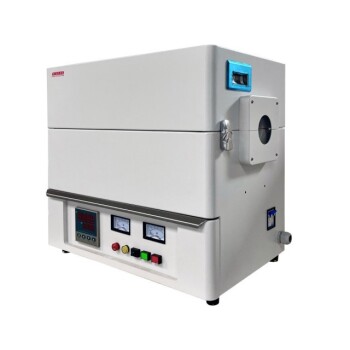The primary attribute of a muffle furnace is its unique design that separates the combustion and heating chambers, ensuring materials are heated without contamination from combustion by-products. This is achieved through a gas-sealed chamber called the 'Retort,' which isolates the sample from direct exposure to flames or fumes. Modern electric muffle furnaces leverage this feature for precision heating in applications like metallurgy, ceramics, and pharmaceuticals, offering programmable temperature control and uniform heat distribution.
Key Points Explained:
-
Separation of Combustion and Heating Chambers
- The defining feature of a muffle furnace is its physical barrier (the Retort) between the heat source and the material being heated.
- This prevents contamination from fuel residues, smoke, or gases, making it ideal for processes requiring purity (e.g., sintering, annealing).
-
Gas-Sealed Retort Design
- The Retort acts as an inert or controlled atmosphere chamber, enabling processes like brazing or nuclear fuel disposal without oxidation.
- Materials like ceramics or metals can be heated uniformly while avoiding chemical reactions with combustion by-products.
-
Versatility in Applications
- Used in refractory metals processing, technical ceramics, and forensics (e.g., incineration of samples to ash for analysis).
- Supports diverse operations: firing, co-firing, reducing, and metallizing due to precise temperature control.
-
Modern Enhancements
- Programmable heating/cooling rates and uniform temperature distribution improve reproducibility.
- Belt or pusher furnace designs (e.g., ceramic belts) automate material transport for continuous processing.
-
Industrial and Laboratory Use
- Robust construction ensures longevity in industrial settings, while compact lab models prioritize precision.
- Standard features include isolation sections and electronic controls for safety and efficiency.
This design philosophy—isolating heat from contamination—makes muffle furnaces indispensable in both research and manufacturing, where material integrity is paramount.
Summary Table:
| Key Attribute | Description |
|---|---|
| Separation of Chambers | Isolates material from combustion by-products, ensuring purity. |
| Gas-Sealed Retort | Enables inert/controlled atmospheres for oxidation-free heating. |
| Versatile Applications | Used in sintering, annealing, forensics, and refractory metals processing. |
| Modern Enhancements | Programmable controls, uniform heating, and automated material handling. |
| Industrial & Laboratory Use | Durable for manufacturing; compact for precision lab work. |
Upgrade your lab with contamination-free heating solutions!
KINTEK’s advanced muffle furnaces combine precision engineering with deep customization to meet your unique research or production needs. Whether you require uniform sintering, controlled-atmosphere annealing, or high-purity incineration, our Retort-designed furnaces deliver unmatched reliability.
Contact us today to explore tailored solutions for your laboratory or industrial workflow.
Products You Might Be Looking For:
High-temperature lab furnace for contamination-sensitive processes
Bottom-lifting muffle oven for easy sample access
Split-chamber CVD furnace for advanced vapor deposition
Multi-zone CVD tube furnace for precise thermal gradients
Customizable CVD equipment for specialized research



















